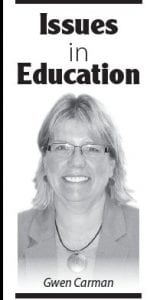It was thrilling to read an email this week that indicated that Broadband will be installed into our school this summer! I cannot say what this means for Broadband’s installation throughout the rest of the county, but it is a long awaited event for us and one that our district very much needs.
Technology is not a “quick fix” to improving education but it does provide many opportunities for us to improve the engagement and individualization of K-12 instruction. And, when education is engaging and individualized, student achievement increases.
Students must learn the core skills they need to be competent technology users in order to be successful users and consumers of technology throughout the 21st century. And of course, one of the challenges is that no one can even predict what type of technology will be available even in five years!
Broadband is critical for us to be able to fully integrate technology tools and Internet resources into our curriculum and instruction. Currently, on a daily basis, our Internet access is slow and/ or we are unable to utilize videos resources, interactive maps, instructional games, live streaming of national events and so much more simply because we do not have the bandwidth to accommodate those types of activities— especially simultaneously through our school.
During our February 8 Professional Development Day, our faculty discussed the decisions we need to make and the planning we must do. We need to be thoughtful and thorough but time is urgent. We are already utilizing technology hardware and software in so many ways but we must develop a much more comprehensive, longterm plan.
Ten key concepts and questions that are part of the technology conversation are:
1. “What device(s) should our students, teachers, administration be using? What are the advantages of IPads (or any other type of tablet) vs. laptops?
2. Do we need to be planning for all students to have their own device or just have class room sets of devices? Should students bring their own? What policies do we need to have in place?
3. What type/how much technology support (personnel) will we need to keep the devices and our infrastructure operating?
4. “Blended Learning” vs. “Online Learning:” Most research suggests that “blended learning” (a “live teacher” that integrates technology [videos, Internet resources, games, etc.] into their teaching is much more effective for most students vs. “online learning” (all communication and instruction is done online).
5. “Distant Learning”: A student takes a class from a “live” teacher during a regular class period via videoconferencing. Several northeastern MN school districts are now doing this.
6. Teacher Training: Teachers need time to learn, to explore, to experiment with the technology tools and resources if we expect them to successfully integrate them into their instruction and curriculums.When will this happen? Who will do this?
7. “In the Cloud” and “Paperless”: We no longer need to rely on “backup servers”. Having documents and emails “in the cloud” makes them far more accessible from any device or location. Students can submit homework online to teachers via “homework drop boxes” and teachers grade them online and return them to students electronically. No worksheets, no “lost” homework, no teachers dragging homework back and forth from school. This saves money, is better for the environment and is already common in many schools and colleges.
8. E-Reading: Reading information on a digital device is a critical skill for technology users. However, most of us need to learn how to do this efficiently. E-readers can also provide great accommodations for students who struggle with reading fluency, speed and/or comprehension. What is the future of heavy, easily worn out textbooks vs. E-licenses? E-licenses enable students to access “textbook information” online (and the resources are updated regularly and much more interactive).
9. Keyboarding & Word Processing: Students will continue to need to “type” but what is the future of traditional keyboarding skills? What is the future of cursive writing instruction?
10. Research Skills: We must teach students how to access and use the vast amounts of information on the Internet efficiently and legally. What class/curriculum should do this? How do we train teachers to provide this instruction?
Cook County Schools is moving forward and is developing a detailed work plan on how we can maximize our use of technology— with the focus on increasing student achievement and preparing students for success in their futures. Please contact me if you would like to be part of our 2013- 18 Technology Planning Team!
Each month a representative of our local schools will offer thoughts in Issues in Education. This month’s s contributor is Gwen Carman, PK-12 principal, Sawtooth Elementary School.



Loading Comments